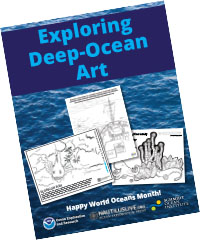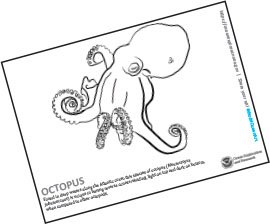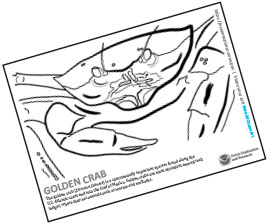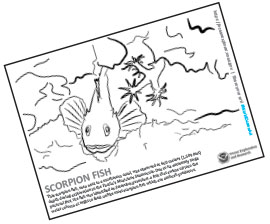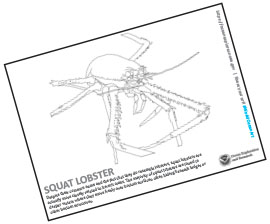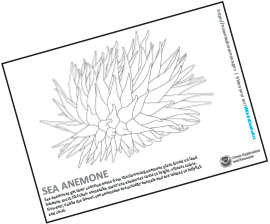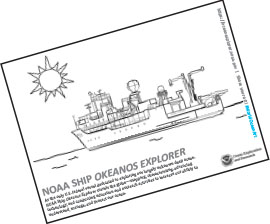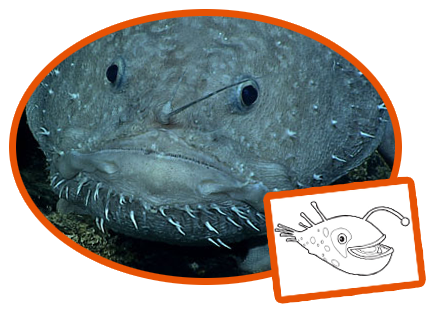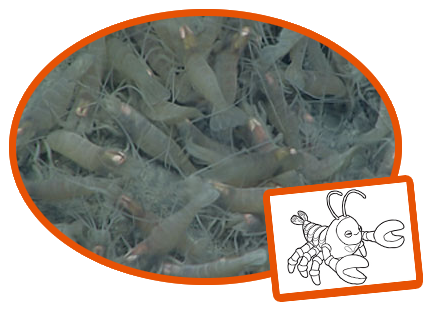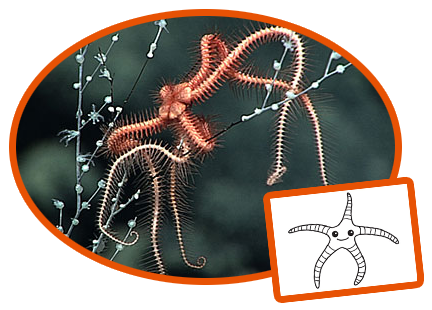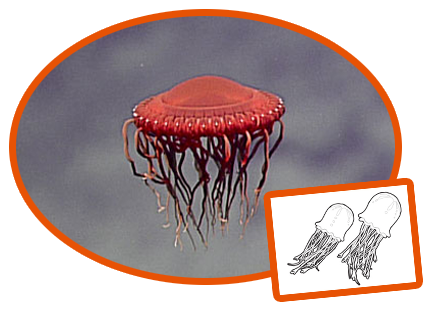An Ocean of Art
In exploring our ocean, we are often gifted with extreme close ups of marine animals we encounter. Art in and of itself, this beautiful imagery is also important scientific data – allowing us closely study and expand our understanding of ocean depths in an unprecedented way. Video courtesy of the NOAA Office of Ocean Exploration and Research. Download (mp4, 69.7 MB).
From the shimmering turquoise of its surface to vibrant fish found at shallow coral reefs, deep red tones of midwater jellyfish, and vivid hues of deep-sea anemones, the ocean is a place brimming with magic, mystery, beauty, and nature’s own artful displays.
Working with our partners at the Ocean Exploration Trust and Schmidt Ocean Institute , we’ve assembled a coloring book to inspire everyone to learn about and appreciate the ocean. You can also download individual coloring sheets below and visit the links to learn more about each featured animal.
When you’ve finished coloring, or if you have a vibrant piece of deep-sea art, post it on social media and tag it #WorldOceanArt, so we can build an Ocean of Art online!
Coloring Sheets
Octopus
Found in deep waters along the Atlantic coast, this species of octopus (Muusoctopus johnsonianus) is unique in having reverse countershading, light on top and dark on bottom, when compared to other octopods. While exploring an unidentified shipwreck in the Gulf of America, we observed this specific octopus writhing all of its arms in a behavior that our resident cephalopod expert had not previously observed in deepwater octopods.
For more:
- Watch a video of the octopus near the shipwreck.
- View other octopus images in our #OctopusFriday Image Gallery.
Golden Crab
The golden crab (Chaceon fenneri) is a commercially important species found along the U.S. Atlantic coast and into the Gulf of America. Golden crabs are most abundant among rock ledges, where they eat animals such as worms and mollusks. This particular crab was seen while exploring Baltimore Canyon off the Virginia coast in the Frank R. Lautenberg Deep-Sea Coral Protection Area at a depth of approximately 530 meters (1,740 feet).
For more:
- Read about deep-sea crustaceans.
- Read more about giant crabs, such as golden crabs, and their relatives.
Scorpion Fish
This scorpion fish, seen next to a mushroom coral, was observed at 460 meters (1,509 feet) depth during exploration in the Pacific’s Musicians Seamounts. Due to its extremely large pectoral fins, the fish was identified as Setarches guentheri, a fish that swims up into the water column at night to feed, unlike most scorpion fish which are ambush predators.
For more:
Squat Lobster
Despite their common name and the fact that they do resemble lobsters, squat lobsters are actually more closely related to hermit crabs. The majority of squat lobsters are found in deeper waters where they move freely over bottom surfaces, often hiding beneath ledges or other bottom structures.
For more:
Sea Anemone
Sea anemones get their common name from the flowering anemone plant found on land because, much like their namesake, many sea anemones come in bright, vibrant colors. However, unlike the flower, sea anemones are actually animals and are related to jellyfish and coral. This one was seen while exploring a fault system that extends nearly 100 kilometers (62 miles) and forms the northern wall of the rift between the Dominican Republic and Puerto Rico, at a depth of approximately 600 meters (1,970 feet).
For more:
- Read more on the basic basic biology on the Phylum Cnidaria, which includes anemones.
NOAA Ship Okeanos Explorer
NOAA Ship Okeanos Explorer is the only federal vessel dedicated to exploring our largely unknown ocean for the purpose of discovery and the advancement of knowledge about the deep ocean. Since the ship was commissioned with NOAA in 2008, expeditions on the Okeanos Explorer have been conducted to explore the Indonesian “Coral Triangle Region,” benthic environments in the Galápagos, parts of the Caribbean, areas in the Gulf of America, canyons and seamounts off the Atlantic coast, and marine protected areas within the Pacific. Missions of the 224-foot vessel include mapping, site characterization, reconnaissance, advancing technology, education, and outreach—all focused on understanding, managing, and protecting our ocean.
For more:
- Read more about the capabilities of NOAA Ship Okeanos Explorer.
- Watch a video tour of the Okeanos Explorer.
Additional Coloring Sheets
The NOAA Office of Ocean Exploration and Research and the Octonauts have teamed up to bring you even more great deep-ocean information, to help you learn about and protect our ocean. Learn more.
NOAA/Octonauts Anglerfish Creature Card
There are more than 200 species of anglerfish, and they are found all over the world. Anglerfish get their name from a small lure on a short stalk between the eyes of female anglerfish. The anglerfish lies in wait, motionless, until suitable prey approaches. When the prey is near, it wiggles the lure vigorously. When the prey approaches to inspect the activity, the anglerfish opens its mouth with lightning speed, engulfing the prey in a matter of milliseconds. This angling behavior is one of the reasons why the anglerfish are among the most successful fishes in the deep sea—they don’t waste energy chasing down other fish!
For more:
- Watch a video of a Schaefer's anglerfish (Sladenia shaefersi) seen during the 2019 Southeastern U.S. Deep-sea Exploration.
- Watch a video of an anglerfish with its lure extended, seen within the Phoenix Islands Protected Area during the Discovering the Deep: Exploring Remote Pacific Marine Protected Areas expedition.
NOAA/Octonauts Vent Shrimp Creature Card
In the deep ocean, hydrothermal vents are often oases of life, with bacteria at the vents serving as a main source of food for other animals—like vent shrimp.
For more:
- Watch a video about life at hydrothermal vents.
- Read about the extreme conditions animals at hydrothermal vents face and how they have adapted to thrive.
- Learn about vents and volcanoes on this Education Theme page.
NOAA/Octonauts Brittle Star Creature Card
Brittle stars, or ophiuroids, are distant relatives of sea stars and are distinguished by having arms which are more sharply set off from the disk, as well as much more slender and brittle. Often occurring in huge abundance, the ecological roles of brittle stars are not well understood. However, they are a successful group found in a multitude of marine settings, from hiding in rocky reefs to carpeting the deep-sea bottom or even to living on jellyfish!
For more:
- Read about sea stars and how these animals eat.
- Watch a video of a brittle star swimming.
NOAA/Octonauts Jellyfish Creature Card
Despite the word “fish” in their names, jellyfish are not actually fish—no bones about it, they are invertebrates! Besides their lack of bones, jellyfish also lack a brain. Instead, they have a network of nerves, but no central nervous system. When feeding, jellyfish use their tentacles to sting their prey—they eat plankton. But what eats a jellyfish? Many animals do, including tunas, sharks, turtles, and humans!
For more:
- Read about jellyfish and see a collection of images of these gelatinous animals.
- Watch a video of a jellyfish seen swimming in the water column during the 2016 Deepwater Exploration of the Mariana expedition.
- Watch a video of a “cosmic” jellyfish seen during the 2017 American Samoa Expedition: Suesuega o le Moana o Amerika Samoa: expedition.
